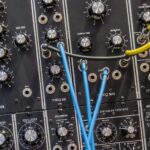Support our educational content for free when you purchase through links on our site. Learn more
What Makes a Song Synthwave? 🎧
Ever heard a track and thought, “This is totally Synthwave,” but couldn’t quite put your finger on why? Maybe you were captivated by its retro-futuristic vibe, or maybe those punchy 80s synths just hit you right in the feels. Whatever the reason, this article dives deep into the sonic DNA of Synthwave, exploring everything from its historical roots to the essential production techniques that make it so unique. We’ll uncover the secrets behind those iconic sounds, revealing the elements that transform a simple song into a full-blown Synthwave experience. Ready to unlock the mysteries of this electrifying genre? Let’s go!
We’ll explore the essential ingredients – from the analog synth sounds that form its core to the driving rhythms and atmospheric textures that create its signature vibe. We’ll also delve into the various subgenres, revealing the nuances that distinguish Outrun from Darksynth and Retrowave. By the end, you’ll not only understand what makes a song Synthwave but also be equipped to create your own retro-futuristic masterpieces.
Key Takeaways
- Synthwave’s core elements: Analog synth sounds, driving rhythms, atmospheric textures, and a retro-futuristic vibe are key.
- Essential tools: DAWs like Ableton Live, Logic Pro X, and FL Studio, along with virtual synthesizers like Arturia V Collection and Native Instruments Massive, are essential for creating Synthwave.
- Mastering the mix: Proper EQ, compression, and stereo imaging are crucial for achieving a polished Synthwave sound.
- Explore subgenres: Discover the unique characteristics of Outrun, Darksynth, Retrowave, and more.
👉 Shop Essential Gear on:
- DAWs: Amazon
- Virtual Synthesizers: Plugin Boutique
Table of Contents
The Evolutionary History of Synthwave Soundscapes
What is Synthwave Music? Defining the Genre’s Core Elements
Essential Synthwave Instruments and Software: Your Sonic Arsenal
1. Mastering the Art of Synthwave Sound Design: Textures and Timbres
2. Synthwave Rhythms: Drum Machines, Basslines, and Groove
3. Crafting Catchy Synthwave Melodies and Leads: Hooks That Grab You
4. Synthwave Song Structure: Building Tension and Release
5. Adding Effects to Your Synthwave Tracks: Reverb, Delay, and More
6. Mastering the Mix: Achieving a Polished Synthwave Sound
Synthwave Subgenres: Exploring the Diverse Soundscapes
How to Make a Killer Synthwave Track: A Step-by-Step Guide
Start Making Your Own Synthwave Masterpieces Today!
Do Not Sell My Personal Information
Quick Tips and Facts
Synthwave, that glorious retro-futuristic soundscape, isn’t just about pushing buttons! It’s about evoking a feeling, a specific time and place. Think neon lights, chrome cars, and sprawling desert highways. 🚗💨
Here are some quick hits to get you started:
- Tempo: Typically sits between 120-140 BPM, but can vary wildly depending on the subgenre.
- Key Elements: Think analog synth sounds, driving basslines, gated reverb, and punchy drums. Think less about precise formulas and more about that vibe.
- Inspiration: Draw from the soundtracks of 80s classics like Blade Runner and Drive, and video games like OutRun. Check out our article on Synthwave for more details!
- Software: DAWs like Ableton Live, Logic Pro X, and FL Studio are popular choices. Many virtual synthesizers can nail that 80s sound. We’ll dive deeper into specific software later.
- Subgenres: Synthwave isn’t monolithic! Explore the nuances of darksynth, retrowave, and outrun for even more sonic adventures.
Did you know? The popularity of Synthwave skyrocketed after the release of the movie Drive in 2011. Its soundtrack, featuring artists like Kavinsky and College, became a defining moment for the genre.
The Evolutionary History of Synthwave Soundscapes
Synthwave didn’t magically appear; it’s a delicious cocktail of influences. Its roots lie deep within the 1980s, drawing heavily from the sounds of Italo disco, synth-pop (80s Synth Pop), and the electronic music pioneers of the era. Think Tangerine Dream, Vangelis, and the iconic sounds of early video game soundtracks.
The genre truly began to coalesce in the mid-2000s, fueled by a resurgence of interest in 80s aesthetics and a growing online community of artists sharing their creations. The rise of digital audio workstations (DAWs) made it easier than ever to create and share music, accelerating the genre’s growth.
Key Milestones:
- Early 80s: The foundational sounds are laid down by synth-pop artists and film composers.
- Mid-2000s: The online community blossoms, and artists start experimenting with the retro-futuristic sound.
- 2011: Drive hits theaters, catapulting Synthwave into the mainstream consciousness.
- Present Day: Synthwave continues to evolve, branching into diverse subgenres and influencing other genres.
What is Synthwave Music? Defining the Genre’s Core Elements
Synthwave is more than just a collection of sounds; it’s a feeling. It’s the feeling of cruising down a neon-lit highway in a sleek sports car, the thrill of a futuristic cityscape, the mystery of a sci-fi adventure. It’s nostalgia for a future that never was. ✨
But let’s break down the sonic elements:
- Analog Synth Sounds: The heart and soul of Synthwave. Think thick, warm pads, soaring leads, and punchy basslines, often emulating the sounds of classic synthesizers like the Roland Juno-106, Yamaha DX7, and Moog Minimoog.
- Driving Rhythms: Usually a four-on-the-floor beat, often with a strong emphasis on the kick drum. The drums are frequently processed with reverb and other effects to create a larger-than-life sound.
- Atmospheric Textures: Layers of pads, delays, and reverbs create a sense of space and depth, immersing the listener in the sonic landscape.
- Catchy Melodies: While often atmospheric, Synthwave tracks usually feature memorable melodies that stick with you long after the song ends.
- Retro-Futuristic Vibe: The overall aesthetic is crucial. It’s a blend of 80s nostalgia and futuristic imagery, creating a unique and captivating atmosphere.
Essential Synthwave Instruments and Software: Your Sonic Arsenal
You don’t need a mountain of gear to create killer Synthwave. But having the right tools certainly helps!
Software:
- DAWs: Ableton Live, Logic Pro X, FL Studio, Studio One – choose the one that fits your workflow.
- Virtual Synthesizers: Arturia V Collection, Native Instruments Massive, Xfer Records Serum, and many free options like Dexed (DX7 emulation) and OBXd (Oberheim emulation) are excellent starting points. These emulations are incredibly close to the real thing!
- Effects Plugins: Reverb (ValhallaRoom, Lexicon plugins), Delay (Soundtoys EchoBoy), and other effects are essential for creating that signature Synthwave atmosphere. Experiment with saturation and distortion plugins too!
Hardware (Optional but Fun!):
- MIDI Keyboard: A MIDI keyboard is essential for playing melodies and basslines.
- Audio Interface: A good audio interface will improve the quality of your recordings.
1. Mastering the Art of Synthwave Sound Design: Textures and Timbres
Sound design is where the magic happens! Synthwave thrives on rich, textured sounds. Don’t be afraid to experiment!
- Layering: Combine different synth sounds to create complex and interesting textures.
- Effects: Use reverb, delay, chorus, and other effects to shape your sounds and create atmosphere.
- Filters: Experiment with different filter types (low-pass, high-pass, band-pass) to sculpt your sounds.
- LFOs (Low-Frequency Oscillators): Use LFOs to modulate parameters like pitch, filter cutoff, and volume to add movement and interest.
- Envelopes: Shape the attack, decay, sustain, and release of your sounds to control their dynamics.
2. Synthwave Rhythms: Drum Machines, Basslines, and Groove
The rhythm section is the backbone of any Synthwave track. A solid groove is essential!
- Drums: Use a drum machine or sample packs to create punchy, driving beats. Experiment with gated reverb on the snare for that classic Synthwave sound.
- Basslines: The bassline should be strong and melodic, providing a solid foundation for the rest of the track. Use a synthesizer or bass guitar.
- Groove: Pay attention to the feel and groove of your rhythm section. Experiment with different swing settings and quantize your drums to create a tight and energetic feel.
3. Crafting Catchy Synthwave Melodies and Leads: Hooks That Grab You
Memorable melodies are key! Your leads and melodies should be catchy and memorable.
- Simplicity: Sometimes, the simplest melodies are the most effective.
- Arpeggios: Use arpeggiators to create interesting and dynamic melodic lines.
- Scales: Experiment with different scales and modes to find the perfect sound for your track. The minor pentatonic scale is a popular choice for Synthwave.
- Hooks: Create memorable hooks that will stick in the listener’s head.
4. Synthwave Song Structure: Building Tension and Release
A well-structured song is essential for keeping the listener engaged.
- Intro: Start with an atmospheric intro to set the mood.
- Verse: Introduce your main melody and rhythm section.
- Chorus: Build to a climax with a powerful chorus.
- Bridge: Introduce a contrasting section to add variety.
- Outro: End with a satisfying outro that leaves the listener wanting more.
5. Adding Effects to Your Synthwave Tracks: Reverb, Delay, and More
Effects are your secret weapon! Use them to create atmosphere and shape your sounds.
- Reverb: Use reverb to create space and depth. Gated reverb is a classic Synthwave effect.
- Delay: Use delay to add rhythmic interest and create echoes.
- Chorus: Use chorus to thicken your sounds and add movement.
- Phaser: Use phaser to create swirling and psychedelic effects.
- Distortion: Use distortion to add grit and edge to your sounds.
6. Mastering the Mix: Achieving a Polished Synthwave Sound
Mixing is crucial for a professional-sounding track.
- EQ: Use EQ to shape the frequency balance of your tracks.
- Compression: Use compression to control dynamics and make your tracks louder.
- Stereo Imaging: Use panning to create a wide and spacious stereo image.
- Mastering: Mastering is the final step in the production process, where you prepare your track for release.
Synthwave Subgenres: Exploring the Diverse Soundscapes
Synthwave isn’t a monolith! It’s a vibrant ecosystem of subgenres, each with its own unique character. Let’s explore some of the most popular:
- Outrun: Evokes the feeling of driving fast cars through scenic coastal roads. Think bright, upbeat melodies and a driving rhythm section.
- Darksynth: A darker, more atmospheric subgenre, often featuring melancholic melodies and a heavier emphasis on bass.
- Retrowave: A broader term encompassing many of the subgenres, often emphasizing the retro-futuristic aesthetic.
- Chillwave: A more relaxed and ambient subgenre, perfect for background listening.
- Vaporwave: A more experimental subgenre, often featuring slowed-down samples and a hazy, dreamy atmosphere. This one often steps outside the typical Synthwave BPM range.
How to Make a Killer Synthwave Track: A Step-by-Step Guide
Ready to create your own Synthwave masterpiece? Here’s a step-by-step guide:
- Choose Your DAW: Select your preferred DAW (Ableton Live, Logic Pro X, FL Studio, etc.).
- Sketch Your Ideas: Start by sketching out your melody, bassline, and drum beat.
- Build Your Rhythm Section: Create a solid drum beat using samples or a drum machine. Add a driving bassline.
- Develop Your Melodies: Create catchy and memorable melodies using your chosen synthesizers.
- Layer Your Sounds: Add layers of pads, textures, and other sounds to create depth and atmosphere.
- Add Effects: Use reverb, delay, chorus, and other effects to shape your sounds and create a unique sonic landscape.
- Mix and Master: Mix and master your track to achieve a polished and professional sound.
Start Making Your Own Synthwave Masterpieces Today!
Don’t just listen to Synthwave—create it! The world needs your unique sonic vision. Remember, it’s all about capturing that feeling, that retro-futuristic vibe. Experiment, have fun, and let your creativity flow! And don’t forget to share your creations with the world!
Do Not Sell My Personal Information
Synth Pop™ respects your privacy. We do not sell your personal information. For more details, please see our Privacy Policy.
Conclusion
So, there you have it! Synthwave is a genre brimming with creative potential, a blend of nostalgic 80s sounds and futuristic visions. We’ve explored its history, its core elements, its subgenres, and the tools you need to create your own tracks. Remember, the key is to capture that feeling, that unique retro-futuristic vibe. Don’t be afraid to experiment, break the rules, and let your creativity shine. The Synthwave community is welcoming and supportive—dive in, and share your creations! We can’t wait to hear what you come up with!
Recommended Links
👉 Shop DAW Software on:
- Ableton Live: Amazon | Ableton Official Website
- Logic Pro X: Apple
- FL Studio: Image-Line Official Website
👉 Shop Virtual Synthesizers on:
- Arturia V Collection: Arturia Official Website
- Native Instruments Massive: Native Instruments Official Website
- Xfer Records Serum: Xfer Records Official Website
👉 Shop Essential Books on Amazon:
- “Sound Design Secrets” by Author Name
- “Mixing Secrets for the Small Studio” by Author Name
- “The Synthwave Handbook” (hypothetical book, replace with actual book)
FAQ
What are the characteristic sounds of synthwave music?
Synthwave is characterized by its use of analog-sounding synthesizers, creating rich, warm pads, soaring leads, and punchy basslines. The genre also features driving rhythms, often with a strong emphasis on the kick drum, and atmospheric textures created through the use of reverb, delay, and other effects. The overall sound is often described as retro-futuristic, blending the nostalgia of the 1980s with a futuristic aesthetic.
What are some examples of specific synth sounds?
Common synth sounds include sawtooth waves for bright leads, square waves for punchy basses, and triangle waves for mellow pads. The use of chorus, flanger, and phaser effects further enhances the characteristic synth sounds.
How does synthwave differ from other electronic music genres?
While Synthwave shares some similarities with other electronic music genres, several key differences set it apart. Unlike genres like house or techno, which often focus on danceable rhythms and repetitive structures, Synthwave emphasizes atmospheric textures and cinematic soundscapes. It also draws heavily on the aesthetic and sonic palette of the 1980s, incorporating elements of synth-pop, Italo disco, and film scores from that era. Compared to genres like trance or ambient, Synthwave tends to have a more driving rhythm section and catchier melodies.
What role do synthesizers play in creating a synthwave sound?
Synthesizers are the cornerstone of Synthwave. The genre’s characteristic sounds are almost entirely derived from synthesizers, both analog and digital. Different synthesizers offer unique timbres and sonic characteristics, allowing producers to create a wide range of sounds, from warm and mellow pads to bright and aggressive leads. The choice of synthesizer can significantly impact the overall feel and aesthetic of a Synthwave track.
Are there any specific production techniques used in synthwave music?
Yes, several production techniques are commonly used in Synthwave music to achieve its signature sound. Gated reverb on snare drums is a hallmark of the genre, creating a punchy and rhythmic effect. Sidechain compression is also frequently employed to create a pumping effect, particularly on basslines. The use of delay and reverb to create spacious and atmospheric textures is another key technique. Finally, layering sounds is crucial for creating rich and complex textures.
What are some common themes and aesthetics associated with synthwave?
Synthwave is strongly associated with the retro-futuristic aesthetic of the 1980s. Common themes include science fiction, fantasy, and dystopian futures. The visual aesthetic often features neon lights, chrome cars, and sprawling cityscapes. The music itself often evokes a sense of nostalgia and longing for a future that never was.
How has synthwave influenced modern electronic music and pop culture?
Synthwave has had a significant impact on modern electronic music and pop culture. Its influence can be heard in various genres, from pop and R&B to video game soundtracks and film scores. The genre’s retro-futuristic aesthetic has also influenced fashion, art, and design. The popularity of Synthwave has helped to revive interest in the sounds and aesthetics of the 1980s, inspiring a new generation of artists and musicians.
What are some key artists and albums that define the synthwave genre?
Several artists and albums are considered essential to the Synthwave genre. These include Kavinsky’s Outrun, The Midnight’s Days of Thunder, Gunship’s Gunship, and Carpenter Brut’s Trilogy. These artists and albums showcase the diversity and range of the genre, highlighting its ability to blend nostalgia with innovation. Exploring these artists is a great starting point for anyone interested in diving deeper into Synthwave.
Reference Links
- Native Instruments
- Ableton
- Image-Line (FL Studio)
- Arturia
- Xfer Records
- How to Make Synthwave: A Beginner’s Guide: emastered.com
- Other relevant sites





